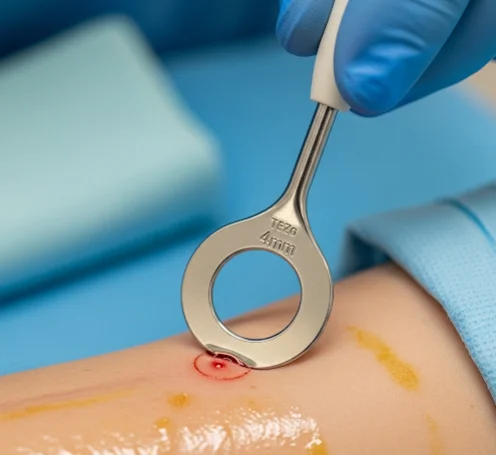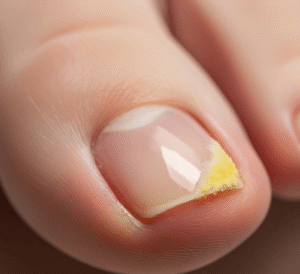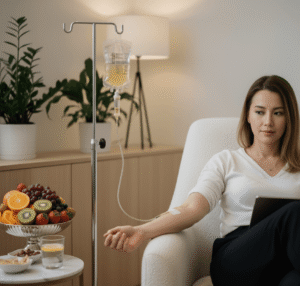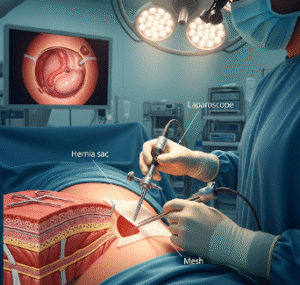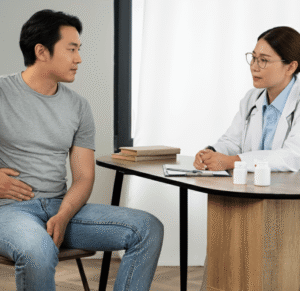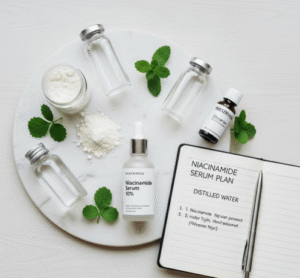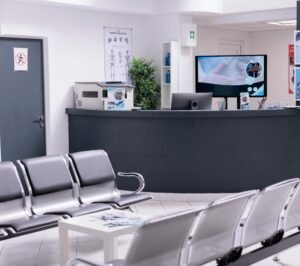What it is
Punch biopsy in Korea is a diagnostic dermatological procedure in which a circular blade (punch tool) is used to remove a small, full-thickness skin sample for laboratory analysis.
Unlike a shave biopsy, which only collects the superficial layers, a punch biopsy provides a deeper cross-section including the epidermis, dermis, and sometimes subcutaneous fat, making it more accurate for diagnosing complex or deeper skin conditions.
→ In Korea, punch biopsies are performed in dermatology hospitals, skin cancer centers, and university clinics, with an emphasis on both diagnostic precision and minimal scarring.
• Used for diagnosing skin cancers, inflammatory skin disorders, rashes, and autoimmune diseases.
• Performed under local anesthesia, with sutures often required for closure.
Why it’s done
Patients in Korea undergo punch biopsy for:
→ Cancer detection → Melanoma, basal cell carcinoma, and squamous cell carcinoma.
→ Rash evaluation → Persistent or unusual rashes that don’t respond to standard treatment.
→ Autoimmune conditions → Lupus, pemphigus, or vasculitis diagnosis.
→ Chronic skin disorders → Psoriasis, eczema, lichen planus, and other inflammatory diseases.
→ Accurate histology → Full-thickness samples give dermatopathologists more reliable information.
Alternatives
Depending on lesion type, alternatives include:
• Shave biopsy → For superficial growths or basal cell carcinoma.
• Excisional biopsy → Removes the entire lesion, preferred for small melanomas.
• Incisional biopsy → Removes only a portion of a larger lesion.
• Fine needle aspiration → Used for deeper nodules but not surface-level skin conditions.
→ Punch biopsy is chosen when deeper layers must be examined but full excision is unnecessary.
Preparation
Before undergoing a punch biopsy in Korea, preparation includes:
- Consultation → Dermatologist determines biopsy type and location.
- Medical review → History of allergies, bleeding disorders, or medications.
- Local anesthesia planning → Lidocaine injection is prepared for numbing.
- Informed consent → Patients are briefed on scar potential, stitches, and recovery.
- Pre-procedure care → Patients should avoid blood thinners (if medically safe) and keep the area clean.
How it’s done
Punch biopsy in Korea is a quick outpatient procedure:
- Anesthesia → Local injection numbs the target area.
- Punch tool insertion → A sterile circular blade (2–6 mm) is rotated into the skin to extract a cylindrical sample.
- Sample removal → The tissue core is gently lifted with forceps and cut at the base.
- Hemostasis and closure
- Small biopsies may be left to heal naturally.
- Larger sites are closed with 1–2 sutures.
- Dressing → Antibacterial ointment and bandage applied.
→ The procedure takes 15–30 minutes.
→ The sample is immediately sent to a pathology lab for analysis.
Recovery
Recovery after punch biopsy is straightforward:
• Healing time → 1–2 weeks for sutured sites; slightly longer for natural healing.
• Stitch removal → Usually in 5–14 days depending on site.
• Scar appearance → Small, round or linear scar, often minimal with proper care.
• Aftercare → Keep the area clean, apply ointment, change dressings daily.
• Sun protection → Prevents post-inflammatory pigmentation at the biopsy site.
→ Patients can return to normal activities immediately, with minor restrictions on stretching the area.
Complication
Possible risks, though uncommon, include:
- Bleeding or infection → Controlled with sterile technique and antibiotics if needed.
- Scarring → Minimal with small punches, but larger samples may leave small linear scars.
- Delayed healing → Possible in areas with poor circulation.
- Pigmentation changes → Temporary darkening or lightening at the biopsy site.
- Pain or tenderness → Usually mild and resolves within a few days.
→ In Korea, risks are minimized through precise surgical technique and advanced scar care.
Treatment option in Korea
Korea offers advanced punch biopsy services with high diagnostic accuracy:
→ Dermatology hospitals and cancer centers → Equipped with on-site pathology labs for rapid turnaround.
→ Experienced dermatopathologists → Ensure detailed analysis of samples.
• Scar management → Post-biopsy care may include silicone gels, whitening creams, or fractional laser to minimize scar visibility.
• Integration with treatment → If cancer or another condition is diagnosed, treatment (Mohs surgery, laser therapy, or medication) can be arranged immediately in the same clinic.
• Medical tourism → International patients often choose Korean clinics for quick, efficient, and cosmetically sensitive diagnostic care.
→ With state-of-the-art tools, expert surgeons, and aesthetic refinement, punch biopsy in Korea provides reliable diagnosis while ensuring minimal scarring and patient comfort.

